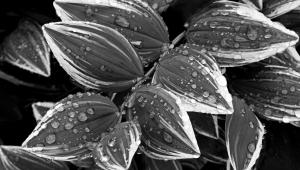How Long Will Your Digital Prints Last?
You May Be Surprised
Editor's Note: In a recent editorial in "Shutterbug" we called for information from manufacturers about the state of the art of digital imaging today, with one main topic being the longevity of "digital" prints. We are very pleased to offer this very precise and informative contribution from Dr. Nils Miller, a senior scientist with HP (Ink & Media division).
Photography is a wide-ranging field that engenders passion in its practitioners,
and like all great forms of expression creates opinions formed through experience
and reflection. In its early days one of the great debates was: Is Photography
Art? This was the subject of many essays and heated discussions among players
and spectators. Today, issues such as film vs. digital, format choices, the
validity of computer generated images, photography as exploitation or revealer,
and even the merits of ink jet vs. silver prints cause similar debate. We are
opening this department up to readers, manufacturers, and retailers--in
short, everyone who lives and breathes photography and who has an opinion about
anything affecting imaging today.
Here's how to get involved: write us an e-mail at editorial@shutterbug.com
or send us a letter with a proposed topic and a synopsis of your idea. Once
approved, we'll ask you to send us about 500-1000 words on the subject
chosen. The idea here is not to push any product or wave any flag, but to create
discussion about photo and imaging topics of the day. We reserve the right to
edit whatever you send in, although we will never edit intention or opinion
but only for length and, hopefully, for clarity. We reserve the right to publish
your work on our website as well, so you can join the archives and be a resource
for opinion for years to come.
So, get thinking and writing and share your Point of View.
--George Schaub
Digital photography has dramatically changed the way we capture, store, and
manipulate images. But the proof is in the print. Photo prints turn digital
images into something tactile, vibrant, transportable, and physical--something
you could proudly display, sell , or purchase at a high-end art gallery.
This transformation brings with it the expectation that the photo print should
last for many years. Most early examples of digital photo printing technology
did not live up to that expectation. Even today there are digital photo printing
choices that will likely not meet longevity expectations.
There are good options for long-lasting digital prints. Following is a discussion
about the general types of printing and paper technologies, and the methods
by which permanence science predicts longevity for display and storage.
The Three Types Of Photo Prints
There are three primary digital printing technologies used today: ink jet, dye
sublimation, and digital silver halide (e.g., lab processed). Ink jet and dye
sublimation printers are the most flexible in terms of location. Ink jet printers
are the most common way to produce digital photo prints.
There are two main types of ink jet ink: pigment based and dye based.
Pigment-based inks contain "particles" of colorant that, due to
their relatively large size, reside on the surface of the print. Although pigment-based
inks typically achieve 50 to over 100 years of display life, the tradeoff between
image quality attributes (e.g., gloss, gray neutrality) and display life present
a challenge for the ink designer. Photo paper choice can affect this longevity
by a factor of two.
Dye-based inks contain molecular colorants that penetrate the paper surface.
Early generations of ink jet dyes and even many dye-based inks available today
have poor print display life--less than 10 years. Fortunately, dye chemistry
advances have enabled 50 or even 100+ years of display life while still preserving
the smooth surface finish and vibrant colors inherent to dyes. But this level
of performance requires innovative dye-based inks (such as HP Vivera Inks) and
the right "matched" paper for that particular ink.
The Two Types Of Ink Jet Paper Technologies
In general, ink jet papers fall into one of two categories. The first category
is "instant dry" porous-coating photo papers (this includes "micro
porous" and "nano porous"). These inorganic coatings are thick
enough to absorb most or all of the ink, and do so by using extremely high surface
area particles. This design spreads out the dyes over a very large surface,
which makes them susceptible to fading from air pollutants such as ozone (discussed
later). Pigmented inks will form pigment layers on top of these paper coatings.
The second category is papers that encapsulate ink jet dyes. For example, on
HP Premium Plus Photo Paper these organic, polymeric coatings swell in thickness
as they absorb the ink, and thus encapsulate and protect the dye from air fade.
A subcategory might be called "partially encapsulating" uncoated
papers such as watercolor papers.
Permanence Science Overview--The Four Permanence Factors
Modern permanence science must consider all key factors when determining how
long a photo will last when it is either stored or displayed. Four primary factors
limit the years of useful print life: Light (if displayed),Temperature, Airborne
pollutants, and Humidity.
Sites for additional information on these factors include www.hp.com/go/premiumplusphoto
(click on "Learn more about HP and WIR photo testing"), and www.Wilhelm-Research.com.
HP and many other major manufacturers consider Wilhelm Imaging Research, Inc.,
as the de facto industry standard for permanencepredictions.
































